Hickey's Music Center History
Hickey's Music Center, founded in 1892, is located in Ithaca, New York amongst the Finger Lakes. We are a full line music service specializing in the print music of all publishers, band, orchestral & popular instruments, accessories for all instruments, high quality instrument repairs, music software and equipment, and most important, friendly service to you, our customer.
We have available to us a virtually unlimited resource of music, instruments and accessories, and keep in stock over 150,000 items for immediate shipment. We routinely stock music most other stores have to special order, and our full line of performance products services the needs of the educational and professional communities both locally and worldwide. We are a regional resource for musical instruments as well, with professional, intermediate and beginner level models from some of the world's top manufacturers. We have regular customers in all 50 states and many countries around the globe. We would like to make you our next "regular" customer. Browse through our pages and see what our tradition is all about.
Our Location
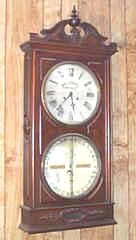
We have one store, located at the corner of Dey and Adams Streets in the pleasant Fall Creek section of Ithaca, New York. Our building was originally constructed in 1875 to house the Ithaca Calendar Clock Company, whose clocks are still made and much sought after even to this day (see photo at right). The building burned to the ground on February 16th, 1876, and was immediately rebuilt, albeit without much of the third floor. It remained the home of the ICCC until the early 20th century when Prohibition* and declining clock sales forced the company into bankruptcy. In the intervening years it has been used as an industrial laundry, a feed store, a fancy bakery, a library and a plumbing shop. Today, it houses our store, offices and warehouse, along with several other small businesses. Get directions to Hickey's Music Center from Anywhere.
* Prohibition? A clock maker? Why? Well, as it would happen to be, the Ithaca Calendar Clock Company was at that time heavily dependant upon sales of clocks not only to banks, schools and corporate offices, but also to beer, wine and liquor companies, who used the fancy machines as premiums and give-aways to their best customers. Apparently this strategy worked well, for the orders kept on coming in. And during the Great Depression, every order counted. When alcoholic beverage sales were wiped out by the 18th Amendment (i.e. Prohibition), those orders disappeared, and that was just too much of a loss for the ICCC. So yes, a clock maker was also a victim of the legislation.
In 1875...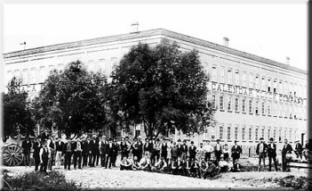 |
Today...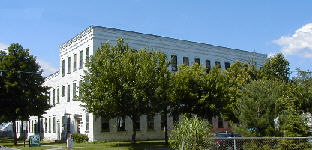 |
Company History
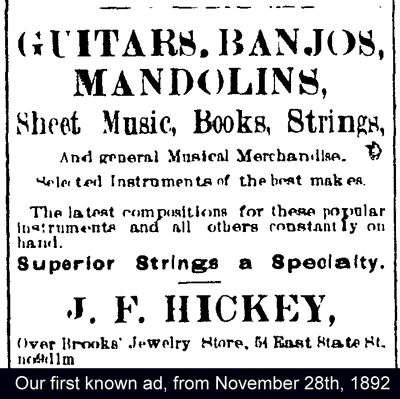
The Early Years (1892-1899)
Hickey's Music Center started out on September 15, 1892 as the J.F. Hickey Music Store, named after its founder, Joseph F. Hickey. Joe was first employed as a clerk in a candy shop, but he soon caught the enteprenurial bug and went into the music business, opening a shop that specialized in guitars, mandolins, banjos, sheet music and accessories. At the time, Joe was well known in town as a fine guitarist and teacher of same. Joe's original store was located at 54 East State Street (currently 152 The Commons due to address realignment by the city), on the second floor above Brooks (now Schooley's) Jewelry Store. In 1896 the store moved to a ground floor location further east on State Street next to the old Ithaca Hotel (across from Simeons, and close to where Madeline's Restaurant is today). Around this time, Mr. Hickey took on a partner, a Mr. George Coleman. Coleman was a star violinist in town and headed up the Lyceum Orchestra, the top performing organization in Ithaca, making its home in the newly opened Lyceum Theater. The firm's name was changed to Hickey & Coleman to reflect the partnership. In addition to teaching violin and other stringed instruments in-house, Mr Coleman also brought additional capital to the business which helped to increase its inventory and offerings, including pianos for the first time. A few years later, Joe and George parted ways and the store reverted to the name Hickey's Music.
The Lyceum Years (1899-1940)
In 1899, the Lyceum Building was completed next door to the Lyceum Theater on North Cayuga Street, home of the Lyceum Orchestra. Hickeys moved in on the ground floor as its first tenant (at 105 N Cayuga, now 107). The store would flourish in this location. The business grew such that Hickey had to rent the adjacent spaces in the Lyceum Building, numbers 107 & 109. During this time the print music library was greatly expanded and band & orchestra instruments were added (we even had our own line of band instruments in those days). Indeed, the print music selection was so large and complete that in the 1930's, Hickey's actually served as the de-facto library for the Ithaca Conservatory of Music (later Ithaca College) during a critical time in the college's history. When telephone service reached Ithaca, Hickey's was assigned the number 2-8262, later AR2-8262, which is still our home number, 272-8262. In 1934, Fred Wilcox purchased the business from Mr. Hickey.
The Eagles Years (1940-1959)
Mr. Hickey, now the former owner, passed away in 1939. A year later, the Lyceum Theater building was torn down. It was then that Mr. Wilcox moved the store two blocks east to its location in the Eagles Building near the "tuning fork" at 326-330 East State Street, where it occupied the entire ground floor. Many Ithaca folk will better remember this building as the longtime home of T.G. Millers art and stationary supplies. The building still stands and now houses Ithaca's Community School of Music & Art (CSMA). It was at this location where piano sales were discontinued after an unfortunate mishap with a customer's car (long story).
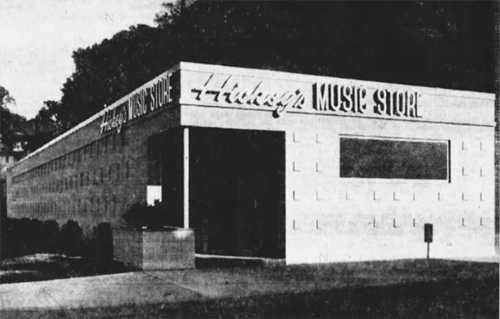
The Legendary Years (1959-1981)
On October 12th, 1959, the store had its formal opening at its famous Green & Tioga Street location, the current site of the county's mental health building. It was here that the store became known throughout the northeastern United States and beyond as *the* location for sheet music. Band, orchestra and choir directors would travel many miles to spend days browsing the stacks to select music for their programs. And Saturdays were always a full house. Indeed, many directors were known to stay late after the store closed, literally locking the door on the way out with the keys and kind permission of the owners, Fred Wilcox and Bob Hedges. Hickey's also became a large mail order company at this time, shipping music throughout the United States and Canada. But, like many old American institutions, the 1970's brought decline. The selection of music thinned, and non-sheet music products were dropped from the line. In 1981, the store moved to the second floor of the Emporium Building (above Logos Bookstore, now Autumn Leaves Bookstore) at 115 The Commons, not far from its original location nearly 100 years before.
Changes of Ownership and Revival (1981-1993)
In 1988 there was a change of ownership when David and Charlotte Scholey purchased the company from Mr Hedges. With the Scholeys, the venerable old company began the long and difficult process of rebuilding. After two years of cleaning, sorting and much carpentry, a great deal had been accomplished, but much more needed to be done. Later that year our first computer system was installed, a wicked fast 286 crunching a dBase accounting package with a "massive" 40MB hard drive (ahh, the good ol days!). Interestingly, we discovered that we were one of the only music stores in the country using a computer, and of those, one of a very few using it to track inventory. In 1990, the current ownership acquired the firm from the Scholeys. Within a year the store was moved yet again to its present location in the Ithaca Calendar Clock Factory building. The rebuilding process was restarted and soon, accessory items were being stocked and sold at a serious discount, followed by long absent guitars, band & orchestra instruments, keyboards and percussion. A year or two later found the store with many major instrument lines, including Armstrong, Artley, Bach, Buffet, Cannonball, Conn, King, Selmer, Schroetter and Yamaha.
The Internet Age (1993-present)
In 1993, the Internet was opened to commercial traffic along with civilian access to the World Wide Web. A few months later (and 102 years after our founding) Hickey's Music became one of the planet's very first Dot Com's with the appearance of our first retail website, a large scale multi-page affair offering a fair percentage of the items in our then 20,000+ piece catalog. Our first website was one of the first internet catalogs of any type anywhere in the world. In the ensuing years, more departments have been brought online, from Gifts to Percussion, Pop Music to Orchestral Scores and more. Today, our website continues to grow, offering at current over 125,000 hand selected items, plus the nearly infinite resources of our vendors and partners. In 2001, responding to increased mail order traffic, the store expanded, moving into and remodeling an empty section of our building, where we opened our mailorder office and warehouse. This is where we process and ship every one of your orders.
The Future
The ownership, management and staff here at Hickey's look forward to a bright future. We are continually enhancing our showroom and selection, updating our website and increasing the efficiency of our mailorder operation. And we will continue to learn from one another and from our customers, train our staff and add new and exciting products. But the real reason we do all this is so that we can concentrate on our main (and most enjoyable) goal—helping our customers make and enjoy music by providing increasingly unique honest one-on-one service. It is to this end that we strive.
